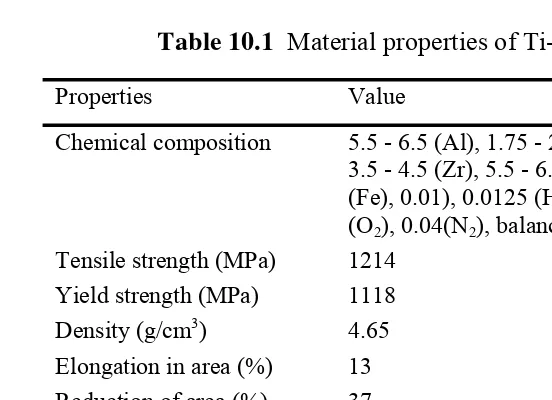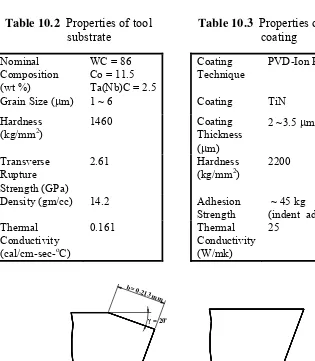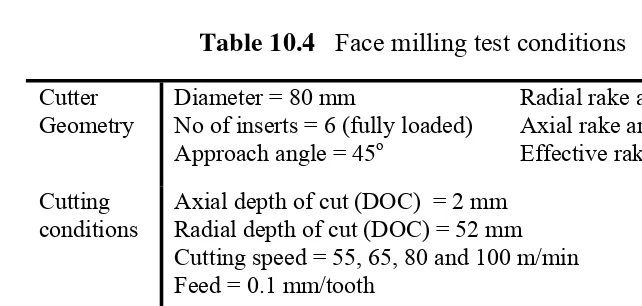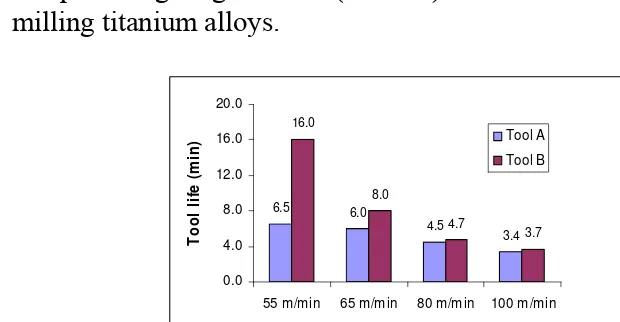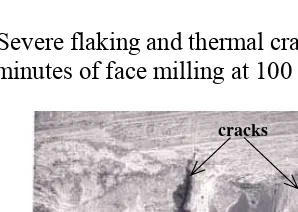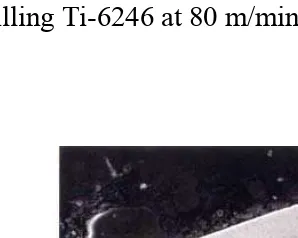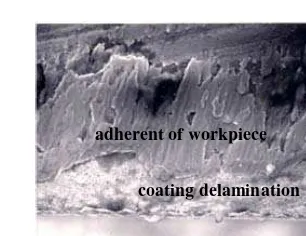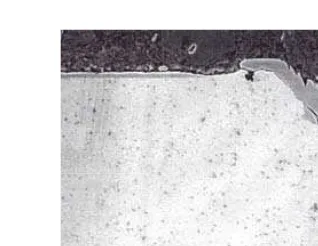First Edition 2008
© ADNAN HASSAN, MASINE MD. TAP & AINI ZUHRA ABDUL KADIR 2008
All rights reserved. No part of this publication may be reproduced or transmitted in any form or by any means, electronic or mechanical including photocopy, recording, or any information storage and retrieval system, without permission in writing from Universiti Teknologi Malaysia, Skudai, 81310 Johor Darul Tak'zim, Malaysia.
Perpustakaan Negara Malaysia Cataloguing-in-Publication Data
Advances in manufacturing and industrial engineering / editors Adnan Hassan. Masine Md. Tap, Aini Zuhra Abdul Kadir.
ISBN 978-983-52-0551-4
1. Manufacturing industrie--Technological innovation. 2. Industrial engineering. 3. Manufacturing processe--Automation. 4. Computer integrated manufacturing systems. I. Adnan Hassan. II. Masine Md. Tap. III. Aini Zuhra Abdul Kadir. IV. Universiti Teknologi Malaysia, Fakulti Kejuruteraan Mekanikal
670.427
Pereka Kulit: MOHD. NAZIR MD. BASRI
Diatur huruf oleh / Typeset by
ADNAN HASSAN & RAKAN-RAKAN Fakulti Kejuruteraan Mekanikal Universiti Teknologi Malaysia, 81310 Skudai
Johor Darul Ta'zim, MALAYSIA
Diterbitkan di Malaysia oleh / Published in Malaysia by
PENERBIT
UNIVERSITI TEKNOLOGI MALAYSIA
34 – 38, Jalan Kebudayaan 1, Taman Universiti,, 81300 Skudai, Johor Darul Ta'zim, MALAYSIA.
(PENERBIT UTM anggota PERSATUAN PENERBIT BUKU MALAYSIA/ MALAYSIAN BOOK PUBLISHERS ASSOCIATION dengan no. keahlian 9101)
Dicetak di Malaysia oleh / Printed in Malaysia by UNIVISION PRESS
Lot 47 & 48, Jalan SR 1/9, Seksyen 9 Jln. Serdang Raya, Tmn Serdang Raya 43300 Seri Kembangan, Selangor Darul Ehsan
v Contents
CONTENTS
Preface vii
Chapter 1 Industrial Engineering in Construction Industry
Masine Md. Tap and Abdul Kadir Marsono
1
Chapter 2 Quality Engineering In Malaysian and Indonesian Automotive Related Industry – a Research Agenda
Nilda Tri Putri and Sha’ri Mohd Yusof
17
Chapter 3 TQM, ISO/TS16949 Certification and Organizational Performance In Malaysian Automotive Industry
Norhayati Zakuan, Sha’ri Mohd Yusof and Awaluddin Mohd Shaharoun
49
Chapter 4 Deriving Success Factors and Quality and Firm Performance in Statistical Process Control Implementation: An Exploratory Factor Analysis (EFA) Approach
Jafri Mohd Rohani, Sha’ri Mohd Yusof and Ismail Mohamad
67
Chapter 5 Classification of Shewhart X-bar Control Chart Patterns Using Artificial Neural Network
Adnan Hassan
vi Contents
Chapter 6 Discrete-Event Simulation Of
An Automotive Part Manufacturing Line Kuan Yew Wong and Hadi Abdul Salaam
109
Chapter 7 End-of-Life Vehicle Directive: A New Paradigm In Modern Vehicle Design And Development Process
Muhamad Zameri Mat Saman
129
Chapter 8 End-of-Life Product Disassembly Analysis Feri Afrinaldi, Muhamad Zameri Mat Saman and Awaluddin Mohamad Shaharoun
163
Chapter 9 Tool Life and Surface Roughness when Turning Hardened Aisi D2 Tool Steel Using Ceramic Cutting Tool with T-Land Cutting Edge
Noordin Mohd.Yusof, Wan Emri Wan Abdul Rahaman, Hendriko and Denni Kurniawan
185
Chapter 10 Face Milling of Titanium Alloy Ti-6246 Using PVD-TiN Coated Carbide Tools Safian Sharif, Amrifan Saladin Mohruni and Ashraf Jawaid
203
Chapter 11 Quantitative Evaluation Of Ductile
Streaked Areas On Ground Optical Glass
Izman Sudin, M. Konneh and V.C. Venkatesh
219
Chapter 12 Computer Integrated Manufacturing Systems
Ashraf Hafiz Radwan
241
Index 257
i Preface
PREFACE
This book present selected advance related to manufacturing and industrial engineering. It presents 12 technical papers written by professors, lecturers, students and associate partners of the Department of Manufacturing and Industrial Engineering, Universiti Teknologi Malaysia.
The issues covered in this book include application of industrial engineering in construction industry, quality engineering, total quality management and ISO/TS16949 certification, statistical process control, control chart patterns classification, end-of-life vehicle design and development process, product disassembly analysis and disposal. Updates related to manufacturing technology covers turning, face milling, tool life, surface roughness, and evaluation of ground optical glass. The book concludes with a chapter on computer integrated manufacturing system.
Many individuals have helped make this book a reality. We are most grateful to the chapter contributors, and all the staff and management of the Faculty of Mechanical Engineering, Universiti Teknologi Malaysia. Without their cooperation, this book would have not come to this completion.
Above all, we thank Allah for granting us perseverance and strength we needed to complete this book.
Editors
Adnan Hassan Masine Md. Tap
Aini Zuhra Abdul Kadir
Department of Manufacturing and Industrial Engineering Faculty of Mechanical Engineering
Universiti Teknologi Malaysia
viii Contributors
CONTRIBUTORS
Abdul Kadir Marsono
Faculty of Civil Engineering,
Universiti Teknologi Malaysia, Malaysia
Amrifan Saladin Mohruni
Dept. of Mech. Engineering, Sriwijaya University, Indonesia
Ashraf Jawaid
School of Engineering,
Coventry University, United Kingdom
Adnan Hassan
Ashraf Hafiz Radwan Denni Kurniawan
Hadi Abdul Salaam (Master Student)
Izman Sudin
Kuan Yew Wong Masine Md. Tap
Muhamad Zameri Mat Saman Noordin Mohd.Yusof
Safian Sharif Sha’ri Mohd. Yusof
Faculty of Mechanical Engineering, Universiti Teknologi Malaysia, Malaysia
Awaluddin Mohamed Shaharoun
Business and Advanced Technology Center, Universiti Teknologi Malaysia, Malaysia
Feri Afrinaldi Nilda Tri Putri
Faculty of Engineering,
ix Contributors
Hendriko
Politeknik Caltex Riau, Indonesia
Ismail Mohamad
Faculty of Science,
Universiti Teknologi Malaysia, Malaysia
M. Konneh
Kulliyyah of Engineering,
International Islamic University Malaysia, Malaysia
V.C. Venkatesh
Department of Mechanical Engineering, University of Las Vegas, U.S.A.
Wan Emri Wan Abdul Rahaman
Faculty of Mechanical Engineering, Universiti Teknologi Mara, Malaysia
Face Milling of Titanium Alloy … 203
10
FACE MILLING OF TITANIUM ALLOY
Ti-6246 USING PVD-TiN COATED
CARBIDE TOOLS
Safian Sharif
Amrifan Saladin Mohruni
Ashraf Jawaid
10.1 INTRODUCTION
The increasing trend of using titanium alloys in aerospace, chemical, biomedical and petroleum industries are mainly due to their attractive properties such as strength to weight ratio, low density, superior corrosion resistance and compatibility with composite materials (Boyer, 1998 and Brewer et. al., 1998). On the other hand, many researchers have classified titanium and its alloys as “difficult to cut materials” with respect to machinability due to their high temperature strength, low thermal conductivity, low modulus of elasticity and chemical reactivity (Hong et. al., 1993). The inhomogeneous deformation by catastrophic shear during machining tends to fluctuate the cutting force and with its low modulus of elasticity, thereby aggravating tool wear and chatter (Machado and Wallbank, 1990).
204 Advances in Manufacturing & Industrial Engineering (2008)
(Souza et. al., 2006, Kramer, 1987, Komanduri and von Turkovich, 1981). Most of the studies have concluded that uncoated WC/Co or straight carbide tool still remains the first choice when turning (Narutaki and Murakoshi, 1983 and Hartung and Kramer, 1982) and face milling (Jawaid et. al., 2000 and Ezugwu and Machado, 1988) of titanium alloys.
Severe chipping and flaking of the cutting edge were reported to be the main failure modes when milling titanium alloys with carbide tools. These types of failure modes are due to the combination of high thermo-mechanical and cyclic stresses, as well as the strong adhesion to and breaking of workpiece material from the tool faces. Despite numerous investigations on milling of titanium alloys (Su et. al., 2006, Usuki et. al., 1996, and Min and Youzhen, 1988), study on the effect of tool edge geometry on cutting performance is still lacking. Previous studies (Paul et. al., 1994, Sidkar et. al., 1992, and Sabberwal and Fleischer, 1964) on face milling of steels have shown that edge bevelling, strengthened the cutting edge and significantly improved the tool life.
This chapter discusses the investigation on the influence of edge chamfering of PVD-TiN coated carbide tools on the tool life performance, tool wear characteristics and failure modes during face milling titanium alloy, Ti-6246 at various cutting conditions.
10.2 EXPERIMENTAL DETAILS
The experimental details of the investigation on face milling of Ti-6246 using PVD-coated carbide tools are discussed in the following sections.
10.2.1 Workpiece Material
Face Milling of Titanium Alloy … 205
mm round bar. The received material was open forged at 9200C in alpha beta condition and air cooled with no further heat treatment. In order to maintain a constant entry and exit angles during face milling trials, one end of the bar where the cutter enters was pre-machined using a spare cutter, whilst the other end was left uncut. The chemical composition and properties of the workpiece material are shown in Table 10.1.
Table 10.1 Material properties of Ti-6246
Properties Value Chemical composition 5.5 - 6.5 (Al), 1.75 - 2.25 (Sn),
3.5 - 4.5 (Zr), 5.5 - 6.5 (Mo), 0.15 (Fe), 0.01), 0.0125 (H2), 0.15
(O2), 0.04(N2), balance (Ti)
Tensile strength (MPa) 1214 Yield strength (MPa) 1118
Density (g/cm3) 4.65 Elongation in area (%) 13
Reduction of area (%) 37 Modulus of elasticity (GPa) 130 Hardness (Hv) 370 – 390 Thermal conductivity (W/mK)
7.7
10.2.2 Inserts
206 Advances in Manufacturing & Industrial Engineering (2008)
Table 10.2 Properties of tool
substrate
Density (gm/cc) 14.2 Adhesion Strength
Figure 10.1 Edge geometry of chamfered tool (Tool A) and sharp
edge tool (Tool B)
Tool A consists of a negative chamfer (γ) of 20o
Face Milling of Titanium Alloy … 207
10.2.3 Machining Test
Face milling tests were carried out on a Sabre 750, 9KW Cincinnati CNC machining centre using the parameters shown in Table 10.4.
Table 10.4 Face milling test conditions
Cutter Geometry
Diameter = 80 mm
No of inserts = 6 (fully loaded) Approach angle = 45o
Radial rake angle = - 11o Axial rake angle = +20o Effective rake angle = +6o Cutting
As recommended by ISO 8688-1 (E), (1989) for milling operation, neutral milling mode was performed to avoid the occurrence of “foot formation” as a result of the unfavourable exit angles. As pointed out by Pekelharing (1984), the presence of “foot formation” could lead to premature tool failure through excessive chipping and fracture of the cutting edge. Concentration of 6 % coolant under flood condition was used throughout the milling tests.
10.2.4 Tool Wear Measurement and Analysis
208 Advances in Manufacturing & Industrial Engineering (2008)
and tool failure modes after face milling at various cutting speeds. Tool rejection or failure was established when any of the following criteria has reached; average flank wear ≥ 0.35mm (average of all six inserts), maximum flank wear ≥ 0.7 mm (on any of the inserts) or excessive chipping/flaking or catastrophic failure of the cutting edge.
10.3 RESULTS AND DISCUSSION
Results of the experimental trials when face milling of Ti-6246 using PVD-coated carbide tools are discussed in the following sections.
10.3.1 Tool Life
Experimental results on tool life when face milling Ti-6246 using chamfered tool (Tool A) and sharp tool (Tool B) are shown graphically in Figure 10.2. Tool B recorded the best tool life performance of 16 minutes at the lowest cutting speed of 55 m/min. when compared to bevelled Tool A which only managed to obtain 6.5 minutes tool life. This implies that an increment of 146% tool life was recorded with Tool B as compared to Tool A. Face milling above cutting speed of 65 m/min showed a significant decrease in tool life for both tools. Shortest tool lives of 3.4 and 3.7 minutes were recorded for Tool A and Tool B respectively at the highest cutting speed of 100 m/min as displayed in Figure 10.2.
Tool A or chamfered tool failed prematurely when short tool lives were recorded at all cutting speeds, probably due to the effect of the negative T-land which may cause unstable cutting hence accelerating chipping and flaking of the cutting edge. As shown in Figure 10.2, the effect of cutting speed on the performance of Tool A was less significant as compared to Tool B. The influence of cutting speed on tool life of Tool B was very significant especially when cutting speed was reduced from 65 to 55 m/min.
Face Milling of Titanium Alloy … 209
15% reduction in cutting speed. Similar results were also reported by Sharif et. al. (2000) in their earlier study on face milling Ti-6Al4V whereby sharp edge tool outperformed bevel under all cutting conditions.
Based on the above findings it is appropriate to suggest that sharp cutting edge insert (Tool B) should be used when face milling titanium alloys.
Figure 10.2 Tool life performance between chamfered tool (Tool A)
and sharp edge tool (Tool B) at various cutting speeds and feed of 0.1 mm/tooth
It is also recommended that cutting speed should remain low for maximum tool life performance of TiN coated carbide tools whenever face milling Ti-6246 is to be carried out.
10.3.2 Tool Wear and Failure Mode
210 Advances in Manufacturing & Industrial Engineering (2008)
tool was too small to cause any significant effect to the tool during machining. In general, the flank wear rate of sharp Tool B was slightly lower than the chamfered Tool A resulting in better tool lives.
Results on the tool failure modes indicated that in most cases, average flank wear with combination of excessive chipping and/or flaking on the rake face were the dominant modes of failure in rejecting both tools especially at higher cutting speeds as shown in Figures 10.3 and 10.4. Thermal cracks were also observed on Tool A (Figure 10.3) and Tool B (Figure 10.4) after reaching their tool life criteria when face milling at 100 and 80 m/min respectively.
Figure 10.3 Severe flaking and thermal cracks on Tool A after 3.5
minutes of face milling at 100 m/min
Figure 10.4 Severe chipping and thermal cracks on Tool B after 5
minutes of face milling at 80 m/min
cracks flaking
Face Milling of Titanium Alloy … 211
Wang and Zhang (1981) reported that the temperature at the tool-chip interface can reach up to 800 o C when face milling Ti-6Al4V at cutting speed of 47 m/min with feed of 0.1 mm/tooth. The high cutting temperature and cyclic mechanical stresses encourage thermally related wear mechanisms to operate such as diffusion, plastic deformation and thermal cracks on the cutting tools. These may eventually promote chipping and flaking of the tool. In this study, machining trials were carried out at higher speeds hence higher temperature generation was anticipated which would further facilitate the thermally related wear mechanisms to operate. It was also observed that at lowest cutting speed of 55 m/min, attrition wear was the major contributor to the occurrence of chipping and flaking on the rake for both tools.
Both tools experienced coating delamination almost instantly (after 5 seconds) as the cutter enters the workpiece. Such evidence is shown in Figures 10.5 and 10.6 for Tool A and Tool B when face milling Ti-6246 at 80 m/min and 55 m/min respectively.
Figure 10.5 Sectioned of Tool A showing delamination of coating on
the bevelled face after face milling for 5 seconds at 80 m/min
212 Advances in Manufacturing & Industrial Engineering (2008)
Figure 10.6 Delamination of coating and adherent of work material on
Tool B after face milling for 5 seconds at 55 m/min
Based on the above findings, it is appropriate to suggest that TiN coatings is not recommended to be used as coating material in protecting the carbide substrate from wear and plastic deformation when dealing with titanium alloys, probably due the high reactivity of titanium material.
Examination of the sectioned worn inserts under the SEM, demonstrates that both Tool A and Tool B suffered severe plastic deformation and adherent of work material when face milling Ti-6246 at high cutting speed. Sample of such deformation on sharp edge (Tool B) is illustrated in Figure 10.7 after 4 minutes of machining at 100 m/min. Trent (1970) pointed out that one of the main contributor for plastic deformation to occur when machining with cemented carbide tools was the extrusion of cobalt content after the softening effect. This softening effect intensifies with higher cobalt content and high cutting temperature as what happened in this investigation. In addition, the high reactivity of titanium towards cobalt elements accelerated the diffusion process hence weakening the structure of the tool substrate.
tion
adherent of workpiece
Face Milling of Titanium Alloy … 213
Figure 10.7 Sectioned of Tool B, showing severe plastic deformation
after face milling Ti-6246 for 4 minutes at 100 m/min
Notching at the depth of cut (DOC), a common
phenomenon in turning of titanium alloys (Hartung and Kramer (1982), Komanduri and von Turkovich (1981)), was not observed on any of the worn inserts of both Tool A and Tool B throughout the face milling trials.
10.3.3 Effect of Edge Geometry
Many researchers (Sharif et. al., 2000, Paul et. al., 1994, Sidkar et. al., 1992, Sabberwal and Fleischer, 1964 and Colwell, 1961) found that bevelling or chamfering of the main cutting edge can influence the tool life quite significantly. Results showed that chamfered Tool A which was originally designed to cater the problem of edge fracture did not exhibit promising results when face milling Ti-6246 as a result of shorter tool lives recorded. Tool life results in Figure 10.2 illustrate that the performance of Tool A was never higher than Tool B at all cutting speeds investigated. The tool life variations of both tools were quite substantial when machining at lower cutting speed between 55 and 65 m/min.
214 Advances in Manufacturing & Industrial Engineering (2008)
with Tool A inserts changed to a negative-negative cutter from a negative-positive cutter which was the case for Tool B inserts. The disadvantages of double negative cutter when machining titanium alloys were probably the reasons underlying the poor performance of chamfered tool (Tool A).
The generation of high cutting forces and the poor ejection of the serrated chips with the negative-positive cutter can cause severe damage to the tool and the workpiece (Stephenson and Agapion (1997), Fowler (1960)). All these factors, coupled with the high cutting temperature at the chamfer face of Tool A may escalate the wear mechanisms of diffusion and attrition thus promoting the occurrence of various failure modes. As a result, rapid flank wear and premature failure of Tool A occurred at all cutting conditions and no improvement in tool life was achieved. Even at the lowest cutting speed of 55 m/min, the tool life obtained was relatively short (6.5 minutes).
Despite experiencing similar failure modes and wear mechanisms as chamfered tool, (Tool A), sharp edge (Tool B) offered much better tool life when machining Ti-6246 at all cutting conditions investigated. The outstanding performance of Tool B was probably due to the favourable geometry of negative-positive cutter which offered many advantages when machining titanium alloys. The negative radial rake angle of the tool provides a strong cutting edge, while positive axial rake angle allows smooth ejection of the chips and reduces cutting force during machining (Stephenson and Agapion, 1997 and Fowler, 1960).
Face Milling of Titanium Alloy … 215
10.4 CONCLUSION
Conclusions drawn from face milling titanium alloy Ti-6246 with two different edge geometry of PVD-TiN coated carbide inserts are as follows:
1. In general, sharp cutting edge inserts (Tool B) produced better tool life performance at all cutting conditions when compared to chamfered/bevelled edge inserts (Tool A) when face milling titanium alloy Ti-6246. The best cutting condition with respect to highest tool life (16 minutes) was achieved with sharp edge inserts (Tool B) at cutting speed of 55 m/min and feed 0.1 mm/tooth.
2. Edge bevelling or chamfering of the cutting edge had not improve the cutting performance of the tools when face milling Ti-6246 as what have been claimed when face milling of steel. 3. A combination of non-uniform flank wear, excessive and
flaking and/or chipping of the cutting edge was the dominant failure mode on both tools at most cutting conditions.
TiN coatings were not able to prevent the occurrence of plastic deformation and thermal cracks at the cutting edge due to its early delamination effect during face milling Ti-6246.
ACKNOWLEDGEMENTS
216 Advances in Manufacturing & Industrial Engineering (2008)
REFERENCES
Boyer, R.R. 1995. Titanium for Aerospace. Rationale and Applications, Advances Performance Materials, 2.
Brewer, W.D., Bird, R.K. and Wallace, T.A. 1998. Titanium Alloys and Processing for High Speed Aircraft. Materials Engineering Science A, 243, pp. 299-304.
Colwell, L.V. 1961. Residual Stresses in Metal Cutting. Handbook of Mechanical Wear, University of Michigan, USA, pp. 403-453.
Ezugwu, E.O. and Machado, A.R. 1988. Face Milling of Aerospace Materials. Proceedings. of the 1st. International Conference on the Behaviour of Materials in Machining, pp. 3.1-3.11.
Fowler, D. 1960. Get More From Your Milling Cutter. Manufacturing Engineering, pp. 74-79.
Hartung, P.D. and Kramer, B.M. 1982. Tool Wear in Machining Titanium. Annals of the CIRP, 31/1, pp. 75-80.
Hong, A.T., Riga, J.M., Cahoon and Scott, C.G. 1993. Machinability of Steels and Titanium Alloys under Lubrication. Wear 162, pp. 34-39.
Jawaid, A. Sharif, S. and Koksal, S. 2000. Evaluation of Wear Mechanism of Coated Carbide Tools When Face Milling Titanium Alloy. Journal of Materials Processing Technology, 99, pp. 266-274.
Kramer B.M. 1987. On Tool Materials for High Speed Machining. Journal of Engineering for Industry. 109, pp. 87-91.
Komanduri, R. and von Turkovich, B.F. 1981. New Observations on the Mechanism of Chip Formation When Machining Titanium Alloys. Wear69, pp. 179-188.
Machado, A.R., Wallbank, J. 1990. Machining of Titanium and Its Alloys – A Review. Proceedings of Institution of Mechanical Engineers, 204, pp. 53-60.
Face Milling of Titanium Alloy … 217
Titanium Alloys. Materials Science and Technology,4, pp. 548-553.
Narutaki, N., and Murakoshi, A. 1983. Study on Machining of Titanium Alloys. Annals of the CIRP,32/1, pp. 65-69. Paul, S., Sikdar, C., Venkatesh, V.C. and Chattopadhay, A.B.
1994. Geometrical Modification of Coated Carbide Inserts for Improved Performance in High Production Face Milling. International Journal of Machine Tools Manufacture, 34, No. 2, pp. 169-182.
Pekelharing, A.J. 1984. The Exit Failure of Cemented Carbide Face Milling Cutters, Part 1- Fundamentals and Phenomena. Annals of the CIRP, 33/1, pp. 47-50.
Sabberwal, A.J.P. and Fleischer, P. 1964. The Effect of Material and Geometry on the Wear Characteristics of Cutting Tools During Face Milling. International Journal of Machine Design and Research, 4. pp. 47-49.
Sharif, S., Jawaid, A. and Koksal, S. 2000. Effect of Edge Geometry on Coated Carbide Tools When Face Milling Titanium Alloy. The International Journal for Manufacturing Science and Technology, 2/2, pp. 11-17. Sidkar, C. Paul, S. and Chattopadhay, A.B. 1992. Effect of
Variation in Edge Geometry on Wear and Tool Life of Coated Carbide Face Milling Inserts. Wear 157, pp 111-126.
Souza, J.V.C., Crnkovic, S.J., Kelly, C.A., Moreira, M.R.V., Ribeiro, M.V. and Silva, O.M.M. 2006. Behaviour of the Silicon Nitride Cutting Tool During Ti-6Al-4V Machining. 5th International Conference on High Speed Machining, France.
Stephenson, A. and Agapiou, J.S. 1997. Metal Cutting Theory and Practice. Marcel Dekker Inc.
Su, Y., He, N., Li, L. and Li, X.L. 2006. An Experimental Investigation of Effects of Cooling/Lubrication Conditions on Tool Wear in High-Speed End Milling of Ti-6Al-4V. Wear 261, pp. 760-766.
218 Advances in Manufacturing & Industrial Engineering (2008)
8688-1 (E).
Trent, E. M. 1970. Wear Processes Which Control the Tool Life of Cemented Carbide Cutting Tools. BSRA-ISI Conference, pp. 10-15.
Usuki, H., Narutaki, N, and Yamane, Y. 1996. Face Milling of Beta Titanium Alloys. Proceedings of the 3rd International Conference on Progress of Cutting and Grinding, Osaka, Japan, pp. 57-62.
